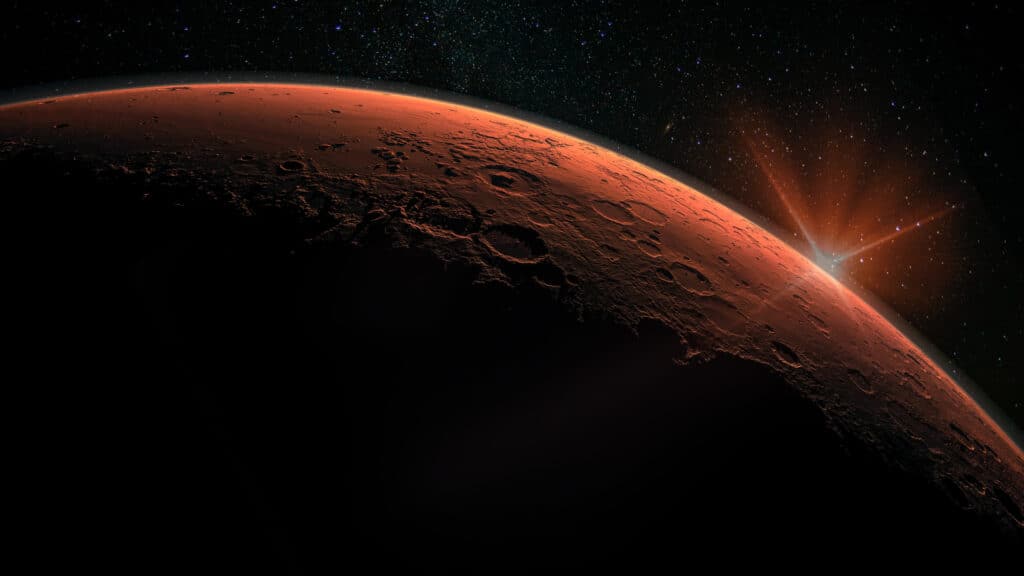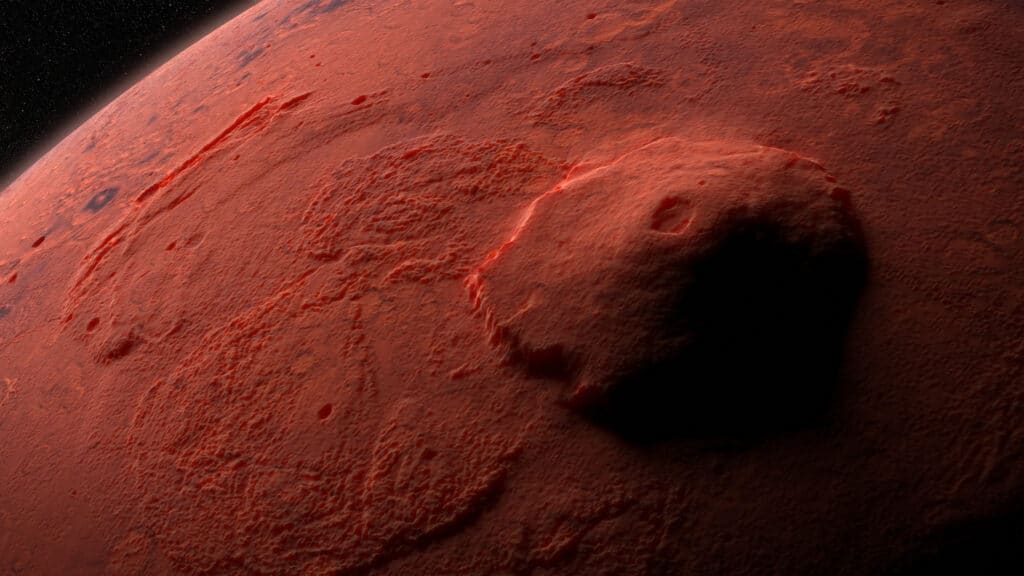Mars is a cold, arid planet that is just half the size of Earth. It has earned the nickname “the Red Planet” due to the presence of rusty iron in its soil. Mars has comparable features to Earth, such as seasons, volcanoes, polar ice caps, and weather. Its atmosphere consists of minimal amounts of carbon dioxide, nitrogen, and argon. Ancient floods are evident on Mars. However, now it is mostly composed of icy dirt and thin clouds. Some hillsides show signs of a salty liquid buried in the ground as well.
Surface Area

The Red Planet’s surface area is 53 percent the size of Earth’s, with a diameter of 4,222 miles.
©iStock.com/Elen11
Mars is the fourth planet from the sun and is considered one of the rocky planets, or terrestrial planets. The surface area of Mars is 144.8 million kilometers squared or 55.91 miles squared. In comparison, the surface of the earth is 196.9 million miles squared (510.1 million kilometers squared).
Its surface area is 53 percent the size of Earth’s, with a diameter of 4,222 miles. This makes it the second smallest planet in our solar system. Only Mercury has a smaller diameter at 3,031 miles. Although Mars is small compared to other known planets, its surface area is close to that of Earth’s since it is primarily composed of deserts rather than water bodies.
Diameter and Circumference
Mars’ oblate spheroid shape means that its polar and equatorial diameters are different. At the equator, it measures 4,222 miles (6,794 km) in diameter. However, from one pole to the other, the diameter is 4,196 miles (6,752 km). Its radius is half of this value, at 2,111 miles at the equator and 2,098 miles from pole to pole. Its circumference around the equator is 13,300 miles. Yet if measured from pole to pole, it drops slightly to 13,200 miles. This difference, along with its odd shape, can be attributed to Mars’ rotation on its axis every 24.6 hours. This causes it to bulge outwards in the middle, like Earth and other rotating planets.
Mass and Gravity
The mass of mars is 6.41 x 10^23 kilograms or 1.41 x 10^24 pounds. The force of gravity on Mars is much weaker than it is on Earth due to its smaller mass. It has a mass that is 10 times less than that of Earth. This difference in gravitational pull means that a 14,000 African elephant would weigh 5,320 pounds on Mars!
The atmosphere of Mars is also very thin compared to the Earth’s atmosphere. This affects how objects move when in flight, such as spacecraft or parachutes released from high altitudes. Because of its lower gravity, landers or rovers sent to the planet have had difficulty remaining stable on the surface. They needed additional measures, such as harpoons, to ensure their stability for data collection. Despite these challenges, however, Mars still remains one of the most explored planets.
Mountains and Valleys

An absolute titan of a mountain, Olympus Mons towers roughly 17 miles high and is one of the largest volcanoes in our entire solar system.
©Dotted Yeti/Shutterstock.com
Olympus Mons is an absolute titan of a mountain, dwarfing even the tallest peaks on Earth. It towers roughly 17 miles (27km) high and is one of the largest volcanoes in our entire solar system. In fact, you could fit New Mexico inside its 370-mile diameter!
The Valles Marineris is also truly unique. This series of valleys runs east-west for over 2,500 miles, which is almost 1/5th of the circumference of Mars itself! This distance would be enough to stretch from Philadelphia all the way to San Diego or cover Australia‘s width entirely. Amazingly, these impressive valleys plunge down as far as 6 miles deep at the lowest points.
Both Olympus Mons and Valles Marineris are remarkable feats of nature. Pondering these landscapes make us appreciate just how vast and diverse the universe truly is.
Time On Mars
Due to Mars’ orbit, one day on the red planet lasts 24.6 hours, just slightly longer than an Earth day. However, because of its larger orbital radius and different tilt axis, it takes Mars almost twice as long to complete one full rotation around the sun.
This means that one year on Mars equates to 687 Earth days. During this time, Mars experiences four distinct seasons: spring, summer, autumn, and winter. These are similar to what we experience here on our own planet. Although they last longer than those on Earth due to the extra length of each Martian year, they are still relatively similar weather-wise. The planet has milder temperatures during summertime and colder conditions during winter months.
Moons of Mars
Mars’ two moons, Phobos and Deimos, are believed to have been asteroids that were captured by the planet’s gravitational pull. They are both relatively small in comparison to other planetary satellites.
Phobos has a diameter of 13.6 miles (21.8 km), while Deimos is only 7.4 miles (11.9 km) across. Both have very low albedo values, meaning they don’t reflect much light from the sun. Scientists think that these moons likely formed from material left over from Mars’ formation process 4.5 billion years ago. Despite their small size, these moons play an important role in our understanding of Mars. Studying them can provide information about the evolution of the Martian atmosphere.
Water On Mars
The planet’s chilly, weak atmosphere means it is unlikely for liquid water to survive on its surface for a significant amount of time. There is evidence of recurring slope lineae that could suggest a temporary flow of briny water. However, this has been contested by some researchers who believe the hydrogen detected might just be from salty minerals.
Signs of water on Mars are everywhere, from wide channels to long valleys and gullies. These suggest that liquid water may have recently moved across the surface of the planet. In 2018, scientists suggested that salty water below the ground could potentially contain enough oxygen to sustain microbial life. But this would depend on the temperature and pressure of the environment, which can shift due to Mars’ changing tilt.
In 2018, the European Space Agency captured what could be a mix of water and sediment underneath the Planum Australe ice. Though some reports called it a “lake,” it is uncertain how much dust is inside the water. This underground lake is similar to those in Antarctica, which have been known to be populated by microscopic organisms. It has a diameter of 12.4 miles or 19.9 kilometers. Furthermore, Mars Express also recently noticed a vast, icy region within the Korolev Crater.
Craters
The Northern Hemisphere of Mars is generally lower in elevation than the Southern Hemisphere. This could have been caused by a massive impact after the planet’s formation. The planet’s northern plains are some of the flattest and smoothest areas in the solar system. These plains may imply that water once flowed on the planet’s surface.
The amount of craters on Mars differs significantly across its surface. The Southern Hemisphere is much older and has more craters, such as Hellas Planitia, which is 1,400 miles wide. On the other hand, the Northern Hemisphere is younger and has fewer craters. Additionally, many volcanoes have only a few craters, suggesting that lava has covered older ones. Some craters have unusual deposits of debris around them that look like solidified mudflows. This could mean that an object from space struck underground water or ice.
The photo featured at the top of this post is © iStock.com/Cobalt88
Thank you for reading! Have some feedback for us? Contact the AZ Animals editorial team.






